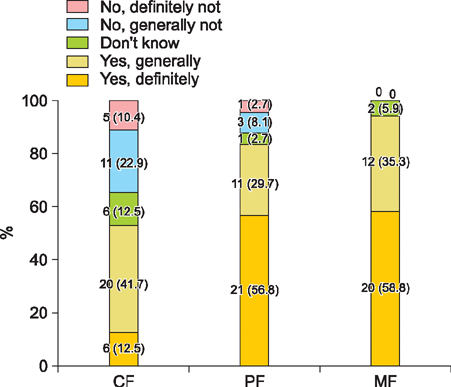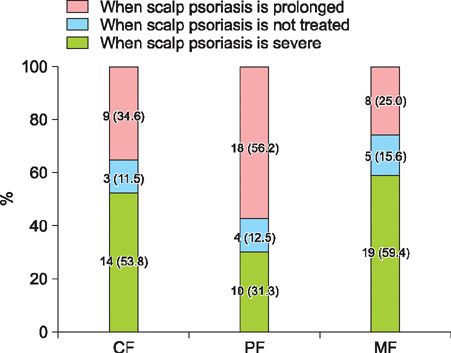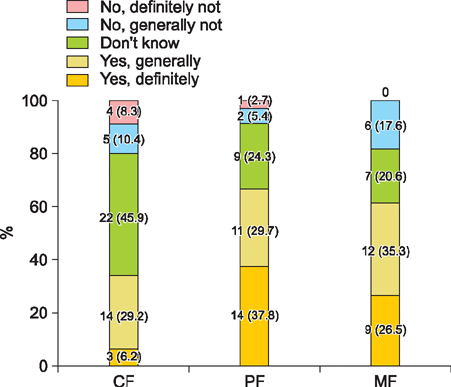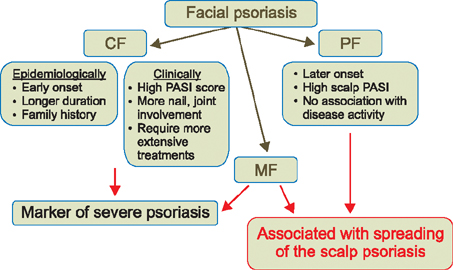Ann Dermatol.
2016 Aug;28(4):422-426. 10.5021/ad.2016.28.4.422.
Relation between the Peripherofacial Psoriasis and Scalp Psoriasis
- Affiliations
-
- 1Department of Dermatology, National Medical Center, Seoul, Korea. nmcderma@daum.net
- KMID: 2344810
- DOI: http://doi.org/10.5021/ad.2016.28.4.422
Abstract
- BACKGROUND
Facial involvement of psoriasis is known to be one of the clinical manifestations that indicate the severity of the psoriasis and thought to be more closely associated with certain distribution. Centrofacial (CF) psoriasis has been suggested to be related with severity of systemic disease while peripherofacial (PF) psoriasis has been thought to have connection with scalp psoriasis.
OBJECTIVE
To analyze the epidemiologic characteristics, clinical features and subjective feelings of patients with facial psoriasis and to find out relationship between scalp psoriasis and facial involvement according to the facial types.
METHODS
One hundred nineteen facial psoriasis patients were categorized into 3 types according to the distribution: PF type, CF type and mixed facial (MF) type. Onset and duration of facial and scalp psoriasis, and their relationship were questioned. Severity and extent of psoriasis on whole body, face, and scalp were rated by clinicians.
RESULTS
There was no significant difference of whole body psoriasis area and severity index (PASI) and body surface area (BSA) score but scalp PASI and BSA was much higher in PF psoriasis compared to CF psoriasis (scalp PASI, 17.9 vs. 10.1; p=0.005) (scalp BSA, 40.9 vs. 22.2; p=0.002). According to the questionnaire, patient's objective feeling about the spreading of scalp lesion to facial area was markedly more prominent in the patients with peripheral involvement (PF+MF, 90.1%; CF, 54.2%; p<0.0001).
CONCLUSION
Among subtypes of facial psoriasis, PF psoriasis is closely associated with spreading of scalp lesion into the face rather than reflecting the disease severity.
MeSH Terms
Figure
Reference
-
1. Yoon HS, Park JY, Youn JI. Clinical study of facial psoriasis. Korean J Dermatol. 2006; 44:1397–1402.2. Farber EM. Facial psoriasis. Cutis. 1992; 50:25–28.3. Harrison PV, Walker GB. Facial psoriasis. Clin Exp Dermatol. 1985; 10:41–44.
Article4. Young Park J, Lim JH, Choe YB, Youn JI. Facial psoriasis: comparison of patients with and without facial involvement. J Am Acad Dermatol. 2004; 50:582–584.
Article5. Fullerton SH, Orenberg EK. Facial involvement as a marker of severe psoriasis. Cutis. 1987; 40:309–310.6. Bernhard JD. Facial involvement is a sign of severe psoriasis. In : Farber EM, Nall L, Morhenn V, editors. Psoriasis: proceedings of the fourth international symposium. New York: Elsevier;1987. p. 405–406.7. Bernhard JD. Facial sparing in psoriasis. Int J Dermatol. 1983; 22:291–292.
Article8. Woo SM, Choi JW, Yoon HS, Jo SJ, Youn JI. Classification of facial psoriasis based on the distributions of facial lesions. J Am Acad Dermatol. 2008; 58:959–963.
Article9. Yoon HS, Choi JW, Youn JI. Method of assessing involved facial areas: rule of fours. Br J Dermatol. 2008; 158:1022–1028.
Article10. Lomholt G. Psoriasis: prevalence, spontaneous course and genetics. Copenhagen: GEC;1963. p. 157–184.11. Youn JI, Park BS, Park SB, Kim SD, Suh DH. Characterization of early and late onset psoriasis in the Korean population. J Dermatol. 1999; 26:647–652.
Article12. Ferrándiz C, Pujol RM, García-Patos V, Bordas X, Smandía JA. Psoriasis of early and late onset: a clinical and epidemiologic study from Spain. J Am Acad Dermatol. 2002; 46:867–873.
Article
- Full Text Links
- Actions
-
Cited
- CITED
-
- Close
- Share
- Similar articles
-
- Therapeutic Effects of Calcipotriol Solution in the Treatment of Scalp Psoriasis
- Comparative Study of Quality of Life in Patients with Scalp Psoriasis Treated Using Topical Steroid Alone vs. Topical Steroid Combined with Cyclosporine
- Two Cases of Combined Geographic Tongue and Fissured Tongue in Generalized Pustular Psoriasis
- A Case of Plaque-type Infantile Psoriasis on Both Flank
- Coexistence of Bullous Pemphigoid and Psoriasis: A Case Report and Review of the Literature





